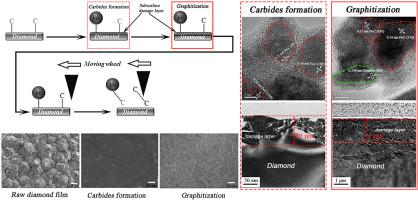当前位置:
X-MOL 学术
›
Tribol. Int.
›
论文详情
Our official English website, www.x-mol.net, welcomes your
feedback! (Note: you will need to create a separate account there.)
Controllability and mechanism investigation on the subsurface damage of CVD diamond film by Fe-containing vitrified bond wheel
Tribology International ( IF 6.1 ) Pub Date : 2021-03-01 , DOI: 10.1016/j.triboint.2020.106774 Mengdi Zhang , Hanqing Xu
Tribology International ( IF 6.1 ) Pub Date : 2021-03-01 , DOI: 10.1016/j.triboint.2020.106774 Mengdi Zhang , Hanqing Xu

|
Abstract Herein, a Fe-containing vitrified bond wheel was used to polish diamond by chemically mechanical polishing (CMP). Due to tribochemical reaction, the hardness of the polished diamond with adhered layers was 1.94 GPa, the corresponding the material removal rate (MRR) was 78.3 μm h−1. As confirmed by TEM and XPS, diamond could firstly react with Fe to form Fe2C, and then diamond-graphite phase transformation during the polishing process. Moreover, the surface damage in the Fe2C generation stage (20–50 nm) was much less than that of the diamond graphitization stage (1 μm). Controlling the reaction conditions in the carbide formation stage could ensure high MRR, while the subsurface damage could be reduced.
中文翻译:

含铁陶瓷结合剂轮对CVD金刚石薄膜亚表面损伤的可控性及机理研究
摘要 本文采用含铁陶瓷结合剂砂轮对金刚石进行化学机械抛光(CMP)。由于摩擦化学反应,抛光后有附着层的金刚石的硬度为1.94 GPa,相应的材料去除率(MRR)为78.3 μm h-1。TEM 和 XPS 证实,金刚石首先与 Fe 反应形成 Fe2C,然后在抛光过程中发生金刚石-石墨相变。此外,Fe2C 生成阶段(20-50 nm)的表面损伤远小于金刚石石墨化阶段(1 μm)。控制碳化物形成阶段的反应条件可以确保高 MRR,同时可以减少次表面损伤。
更新日期:2021-03-01
中文翻译:

含铁陶瓷结合剂轮对CVD金刚石薄膜亚表面损伤的可控性及机理研究
摘要 本文采用含铁陶瓷结合剂砂轮对金刚石进行化学机械抛光(CMP)。由于摩擦化学反应,抛光后有附着层的金刚石的硬度为1.94 GPa,相应的材料去除率(MRR)为78.3 μm h-1。TEM 和 XPS 证实,金刚石首先与 Fe 反应形成 Fe2C,然后在抛光过程中发生金刚石-石墨相变。此外,Fe2C 生成阶段(20-50 nm)的表面损伤远小于金刚石石墨化阶段(1 μm)。控制碳化物形成阶段的反应条件可以确保高 MRR,同时可以减少次表面损伤。











































 京公网安备 11010802027423号
京公网安备 11010802027423号